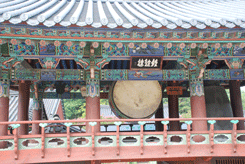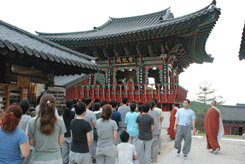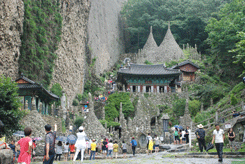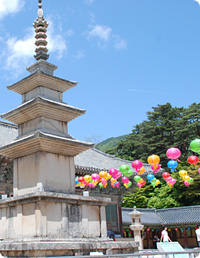Temples
 |
 |
 |
A Buddhist temple is a place practicing the teachings of the Buddha and one should take ordination in order to attain enlightenment by helping the living beings, and taking communal living, meditation, religious exercises, test studies and listening to the words of great monks and nuns. At first, the candidate becomes an aspirant. On entering the monastery, he/she cuts off relations with the outside world for a time, symbolized by shaving hair and beard and wearing a gray or brown gown. Traditionally, shaving the hair is a renunciation of rank, as well as a way to reduce cavity and to be more hygienic. During this period, the aspirant studies basic sutras and chants, does chores about the monastery and cares for the senior monk. The aspirant is given ordination and takes the first set of basic training rules they should accept. They are as follows.
1. Do not kill anything
2. Do not take anything that is not given
3. Be celibate
4. Do not lie
5. Do not take intoxicants
6. Do not adorn oneself
7. Do not seek comfort
8. Do not amass wealth
9. Do not delight in singing, dancing or shows
10. Do not eat outside of mealtimes
After three to five years, if the teacher sees fit, the novice is sent for the second ordination and becomes a Bhiku or Bhikuni for women or a full member of the monastic community. Every day begins at 3 AM. One monk rises a little earlier and puts on ceremonial robes. Slowly, he/she walks to each part of the monastery informing everyone that it is time to rise. The clear sound of the Moktak, a hollowed, wooden bell-shaped percussion instrument, breaks the stillness of the pre-dawn hours and is accompanied by chanting.
After a short time, a large bell, followed by the drum, gong and wooden fish are ringed to call all monks to the main hall. After communal chanting, the students go to the study hall, and the meditating monks go to their places of duty. Breakfast is at about 6 AM. Chanting and offering rice, thus remembering the Buddha's custom of eating once a day, takes place at 10:30 AM. Lunch is the main meal of the day. After lunch and a short free period, all return to their respective activities until supper time at about 5 PM. followed by evening chanting. Quiet study or meditation follows.
Bedtime is usually at about 9 PM. Meditation is highly stressed in the Korean Buddhism. Practitioners have few possessions except for a backpack in which they carry their bowls for eating and robes. In his search for enlightenment, the meditating monks live unattached like clouds in the sky or flowing mountain stream. Retreats last for three months in the summer starting on the 15th of the 4th lunar month and ending on the 15th of the 7th lunar month (May to August) and three months in the winter starting on the 15th of the 10th lunar month and ending on the 15th of the first lunar month (November to January).
There are four meditation sessions a day, pre-dawn, morning, afternoon and evening, which are composed of 50 minutes of sitting down and ten minutes of walking. Before a session, a hollowed out bamboo rod (Jukbi) is struck three times. Fifty minutes later, another Jukbi sound heralds the start of the ten minute walking meditation. Afterwards all sit down again to continue the sitting meditation. At the end of the session, the Jukbi is struck three times again. Once a year in many temples, or twice in bigger ones, there is an intensive, one week meditation. During the week, people meditate up to twenty hours a day, and the sessions are interspersed with silent meals.
Each year is divided into four seasons. The temple life, ever close to nature as possible, follows the change of the seasons. The summer and winter are reserved for meditation and retreat, and the spring and autumn for wandering, seeking instruction and doing service. At different times during the year, there are changes in schedule. In their later life, once training is completed, monks chose from different ways of life. Some monks go to the university, while some are called upon to do administrative jobs. Sometimes a group will decide to do a three-year meditation retreat, sometimes monks will go abroad to teach. Apart from the daily chanting periods, there are special ceremonies for other occasions. Memorial services are quite frequent. Offerings of food are placed on the altar and monks chant, accompanied by the rhythmic beating of the Moktak.
The five main Buddhist holidays are richly celebrated each year, according to the lunar calendar: Buddha's Leaving Home (2nd month, 8th day), Buddha's Passing (2nd month, 15th day), Buddha's Birthday, (4th month, 8th day), All Spirits Day, (7th month, 15th day), and Enlightenment Day (12th month, 8th day). There are also ceremonies for marriages, births and special birthdays.






